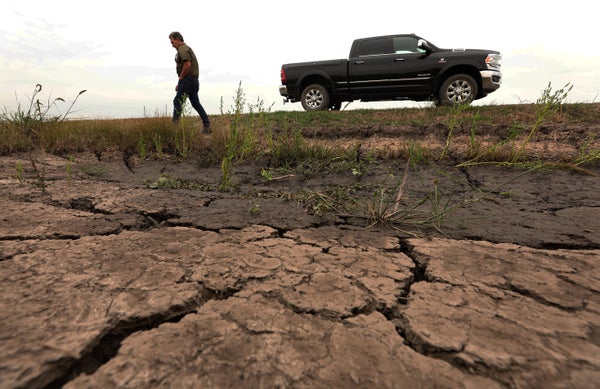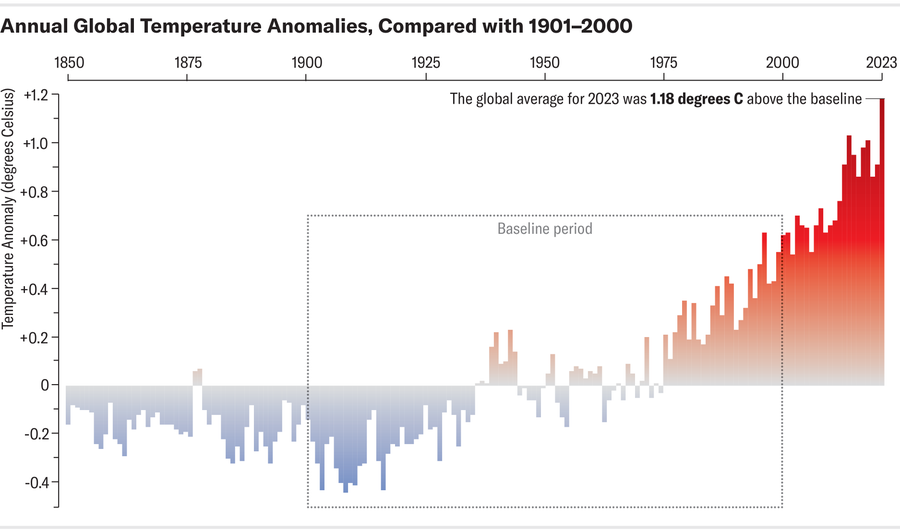January 12, 2024
4 min read
The year 2023 is officially the hottest on record, edging close to the mark of 1.5 degrees Celsius above preindustrial levels. But that doesn’t mean that the goals of the Paris climate accord are out of reach

A farmer walks by dry cracked earth on his farm where he usually grows crawfish on October 10, 2023 in Kaplan, Louisiana.
The world’s major climate agencies have weighed in, and it’s clear that 2023 was the hottest year on record by a long shot. Last year was 0.15 degree Celsius (0.27 degree Fahrenheit) above the previous record holder, 2016, according to the U.S. National Oceanic and Atmospheric Administration. That margin is itself a record.
“After seeing the 2023 climate analysis, I have to pause and say that the findings are astounding,” said NOAA chief scientist Sarah Kapnick in a statement from the agency. “Not only was 2023 the warmest year in NOAA’s 174-year climate record—it was the warmest by far.”
Last year’s heat also flirted very close to the marker of 1.5 degrees C (2.7 degrees F) above preindustrial temperatures—a stark reminder of the urgency of the climate crisis.
“Humanity’s actions are scorching the Earth. 2023 was a mere preview of the catastrophic future that awaits if we don’t act now. We must respond to record-breaking temperature rises with path-breaking action,” said United Nations secretary-general António Guterres in a statement from the World Meteorological Organization (WMO) .
According to NOAA’s data, the planet’s surface temperature in 2023 was 1.18 degrees C (2.12 degrees F) above the 20th-century average—and 1.35 degrees C (2.43 degrees F) above the preindustrial levels. The European Union’s Copernicus Climate Change Service (C3S) found that annual global temperatures reached 1.48 degrees C above preindustrial levels. (Each climate agency uses slightly different methods to analyze climate data, which can cause minor differences among the agencies’ temperature estimates.)
The margin between the record in 2023 and the previous one in 2016 may seem small, but it’s exceptionally large on the scale of global annual temperatures. “Most records are set on the order of a few hundredths of a degree, so this is a big jump,” said Russ Vose, chief of climate monitoring and assessment at NOAA’s National Centers for Environmental Information, during a press briefing on Friday.
Last year also featured the two hottest months ever recorded—July, followed by August—and the most anomalously warm month, September. It was about 0.5 degree C (0.9 degree F) hotter than the previous hottest September in 2020 and a stunning 0.2 degree C (0.4 degree F) warmer than the previous record high temperature anomaly. In 2023 every month from June onward was the hottest such month on record.
According to C3S, nearly half of the days of last year were more than 1.5 degrees C warmer than the preindustrial period, and two days (in November 2023) registered two degrees C warmer than that period for the first time. It was also the first year in which every day was one degree C above the temperature of that time during the preindustrial period.
Last year’s superlative temperatures were almost entirely linked to climate change. A small boost in heat came from the switch in one of Earth’s natural climate cycles. In 2022 the world was in a La Niña state, which has a cooling effect on global temperatures, whereas in 2023 its flip side, an El Niño, emerged, giving global temperatures a boost. But that nudge from the El Niño was relatively small, compared with the heat effect from greenhouse gases that had accumulated in the atmosphere. And the El Niño can’t explain all of the huge leap from 2022 to 2023, said Gavin Schmidt, director of NASA’s Goddard Institute for Space Studies, during the press briefing. Given that the current El Niño has not been exceptionally warm (as the one that rocketed 2016 into the top slot was) and that some of last year’s record heat emerged before the event got going, it cannot explain all of 2023’s record. It will take dedicated study to tease out what is at play, Schmidt said.
Evidence of a long-term warming trend that has been fueled by the burning of fossil fuels can be seen in other records: since the 1980s every decade has been hotter than the preceding one, according to the WMO. And the 2020s should be no exception. The 10 hottest years on record have all occurred in the past decade, according to NOAA data.
Scientific studies have also linked specific weather and climate events—particularly heat waves but also droughts and downpours—to global warming. One study found that heat waves that roasted the U.S. Southwest and Europe last summer would have been “virtually impossible” without climate change.
As hot as 2023 was, it may not hold the title for long, partly because of the ongoing El Niño, which will peak this winter. The global temperature effects of El Niño always lag the peak of the event. Its influence means there is a “reasonable probability” that 2024 could surpass the 1.5-degree-C mark, according to C3S. That aligns with a study conducted last year by the WMO and the U.K.’s Met Office that predicted a 66 percent chance that at least one year between 2023 and 2027 would pass that threshold.
Beyond calendar years, C3S expects the 12-month period ending this month or next will exceed 1.5 degrees C above preindustrial temperatures.
But even if the world passes that point for one year, it does not mean that the goals of the Paris climate accord are out of reach. Those goals refer to the average of multiple years, not a single year.
“We cannot afford to wait any longer. We are already taking action but we have to do more and we have to do it quickly,” said WMO secretary-general Celeste Saulo said in the organization’s statement. “We have to make drastic reductions in greenhouse gas emissions and accelerate the transition to renewable energy sources.”


























































